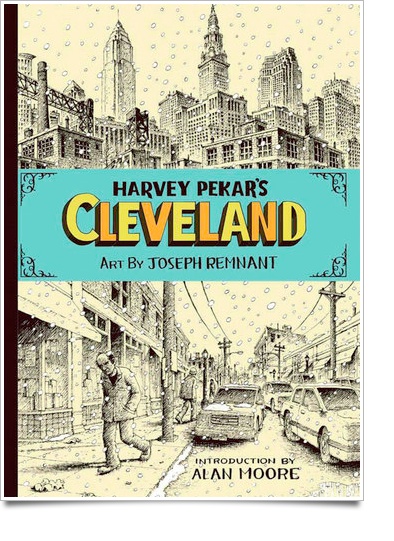
Reviewed by Bert Stratton
Harvey Pekar’s Cleveland is a hodgepodge — one of Pekar’s lesser works.
The first half of the book reads like boilerplate from an old history book. For instance, Pekar writes: “In 1795, the state of Connecticut held the ‘western Reserve’ tract in which Cleveland was to be located. Investors in the Connecticut Land Company got together and sent an exploratory party, headed by Moses Cleveland [sic], to assess its potential.”
This dreary history lesson goes on for 25 pages, taking us all the way from Moses to the burning river, to Kucinich.
Alan Moore, a graphic novelist, wrote the book’s introduction. That’s where the confusion begins. Moore writes: “Cleveland is a part of Harvey Pekar, just as in his resting place amongst the like of John D. Rockefeller, Elliot [sic] Ness and various illustrious untouchables him and his story are eternally part of the narrative of Cleveland, with the man and his environment inseparably become one thing.” Did Alan Moore write that in French and hit Google Translate?
Pekar was a good journalist with a good eye; he would have caught misspellings of “Eliot Ness” and “Moses Cleaveland.” On page 72 there is Sue D’agatano. That’s “Suzanne DeGaetano,” co-owner of Mac’s Backs on Coventry Road.
The illustrations by Joseph Remnant are well-done, but have no Cleveland feel. One panel is a 1940s Cleveland diner with a sign near the window: “We serve whites only.” Was Remnant thinking of Cleveland, Mississippi?
The second half of the book is about Harvey’s personal life, and it’s better than the first half. Harvey talks about people and events he actually didn’t “research.” He listens to radio DJ Bill Randle; looks for used books at Kay’s Bookstore downtown; and has disputes with his second wife. However, Harvey covered all this slice-of-life material better, and more in depth, in his previous books. Nobody sticks around for very long in Harvey Pekar’s Cleveland. It’s mostly about Harvey getting the reader and Cleveland up to 2010 and the medical mart.
Of course, Pekar — like any deceased author — deserves to be judged by his best work. Check out his first 15 or so American Splendors. Re-read the classic stories, the ones about the VA hospital docs, car troubles, old Jewish ladies in line at Pick-n-Pay, and trading “sides” (LP records) with Robert Crumb.
Or dip into Pekar’s first posthumous work, Huntington, West Virginia “On the Fly” (2011). Harvey still had his fast ball for a few innings there. In Huntington West Virginia “On the Fly,” Harvey wrote about Big Fun store owner Steve Presser, who moved a diner from Pennsylvania to Lee Road, Cleveland Heights, and almost went broke in the process. Presser comes across as a completely rounded-out Coventry character.
There’s nobody like that in Harvey Pekar’s Cleveland.
[Illustration by Ralph Solonitz]
 Yiddishe Cup’s bandleader, Bert Stratton, is Klezmer Guy. He knows about the band biz and — check this out — the real estate biz too. So maybe he’s really Klez Landlord. You may not care about the real estate biz. Hey, you may not care about the band biz. His blog Klezmer Guy (http://YiddisheCup.com/blog) has a gamy twist. It features tenants with snakes and skunks, and musicians with smoked fish in their pockets. Klezmer Guy was a reporter for Sun Newspapers. He has written for Rolling Stone, the Cleveland Plain Dealer and the New York Times. He won two Hopwood Awards.
Yiddishe Cup’s bandleader, Bert Stratton, is Klezmer Guy. He knows about the band biz and — check this out — the real estate biz too. So maybe he’s really Klez Landlord. You may not care about the real estate biz. Hey, you may not care about the band biz. His blog Klezmer Guy (http://YiddisheCup.com/blog) has a gamy twist. It features tenants with snakes and skunks, and musicians with smoked fish in their pockets. Klezmer Guy was a reporter for Sun Newspapers. He has written for Rolling Stone, the Cleveland Plain Dealer and the New York Times. He won two Hopwood Awards.


One Response to “BOOK REVIEW: Harvey Pekar’s Cleveland”
TWO GUYS FROM CLEVELAND: Real Music & Real Estate . . .
[…] work — by Hem, Hendrix, Heller, whomever — should stay buried. The Pekar review is here, at today’s CoolCleveland. Need more Pekar? See the archived “Klezmer Guy” […]